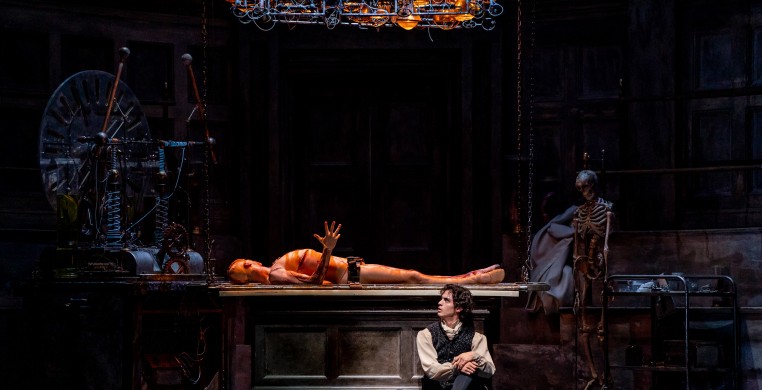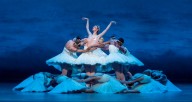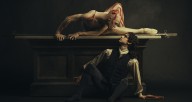Liam Scarlett’s “Frankenstein,” presented at the Lyric Opera House by The Joffrey Ballet, breathes new life into a worn-out property. The dancing relays the tragic tale acutely. Production Designer John Macfarlane and composer Lowell Liebermann bring classic horror movie and 18th-century aesthetics to life to create a sort of “living film.” The characters are reimagined, some roles are expanded, and surprises await even die-hard fans of the misanthropic monstrosity.
For an in-depth look at the production of “Frankenstein” and an interview with stager and artistic supervisor of the Scarlett Trust, Laura Morera, please check out our preview here.
The tone is set before the dancing begins. A ghastly human skull hangs floor-to-ceiling on a scrim. During the overture, animated projections melt the skull into a putrid oil slick of decomposed human remains, revealing a sprawling backdrop of snow-covered mountains.
We meet the Frankenstein family of Geneva as they dance in the marble foyer of their mansion. In upper class European 18th-century attire, Patriarch Alphonse (Miguel Angel Blanco) in long coat and grey periwig, celebrates the pregnancy of his wife, Caroline Beaufort (Anais Bueno). Amidst saltatorial revelry by friends and family, house manager Madam Moritz (Christine Rocas) stoically observes the festivities, eyeing Victor (José Pablo Castro Cuevas) and Elizabeth (Amanda Assucena), as they take to somewhere more private.
 Amanda Assucena (Elizabeth) and José Pablo Castro Cuevas (Victor); Photo by Cheryl Mann
Amanda Assucena (Elizabeth) and José Pablo Castro Cuevas (Victor); Photo by Cheryl Mann
Victor, moved by the festivities, announces his love for Elizabeth, an orphan whom his parents adopted as a child. In a touching pas de deux, we see Scarlett’s choreographic influence in full force, introducing movement themes that reappear throughout the show.
The collaboration between music and dance is intricate and detailed. Victor confidently tosses Elizabeth from one side of his body to the other, mimicking a low-to-high-pitch crescendo that ripples through the orchestra. He drags her across the floor, the gliding of her toes matching sustained notes in the violins.
Following a tragedy, Victor leaves the family and Elizabeth to attend college in Ingolstadt. There he meets his only friend, Henry Clerval (Xavier Núñez). In a high-walled schoolroom, Victor examines cadavers under the tutelage of Professor Waldman (Dylan Gutierrez), a stuffy professor who denounces Victor’s interest in “natural philosophy” by grabbing the book out of his hands and dashing it to the floor.
Meanwhile, posh-dressed male students canoodle with female nurses carrying jars of preserved organs. To a crescendo in the music, the nurses are lifted overhead in long arches, their flowing medical gowns painting the air a soft powder blue.
Victor remains adamant. In the Act 1 finale, he takes to the lab and begins work on his experiment by grabbing and sewing together discarded body parts. Corpse assembled, a hanging contraption made of sparking lightbulbs and glowing wires descends.
Sparks fly! Lightning licks the walls! A hand moves… The creature is born!
Scarlett’s iteration is a completely new take on the creature. Joffrey dancer Jonathan Dole, bald and wearing a nude-colored bodysuit laced with blood-red scars, moves like a man-spider with bones of rubber and superhuman strength.
 "It's alive!"; Photo by Cheryl Mann
"It's alive!"; Photo by Cheryl Mann
Back among the mountains of Geneva, the creature observes the Frankenstein family from the cover of the nearby forest. It imitates their dances and learns their “language.” It attempts to befriend Victor’s younger brother, William (Sheppard Littrell), whose visceral reaction to the creature’s appearance leads to a foul murder.
The body count rises in Act 3. The creature infiltrates the wedding party of Victor and Elizabeth, slipping between the arms of guests during waltzing pas de bourrées.
The killing spree begins. Friends and guests are picked off one by one. The creature’s plan for revenge doesn’t stop there.
Scarlett’s use of momentum, so whimsical in the first pas de deux between Victor and Elizabeth, is now used to convey extreme violence.
The creature is animalistic, toying with its prey before delivering the coup de gras. It ambushes Elizabeth, lifts her in the air, doubles her height. Her arms and body freeze in a pose like a crucifix. It spins her around and throws her to the floor. She waves for help, but her legs are swept out from under her. In a swoop the creature grasps her hair and pulls her to her feet.
It’s a frightening scene! Yet even that doesn’t prepare you for the final moments, a twist ending more gruesome and unexpected—yet poignant and thought-provoking—than any version I’ve ever experienced.
Scarlett’s “Frankenstein” is an homage to Mary Shelley’s classic story of loss and search for humanity. The dancers of The Joffrey Ballet take notable risks, their commitment to the momentum-laden moves making both love and violence breathtakingly palpable. From page to stage, this version of “Frankenstein” comes to life like never before.
“Frankenstein” is presented by the Joffrey Ballet from Oct. 12 – 22 at the Lyric Opera House, 20 N. Wacker Dr. Single tickets start at $36 and are available for purchase at Lyric Opera Box Office, by telephone at 312.386.8905, or online at Joffrey.org.



